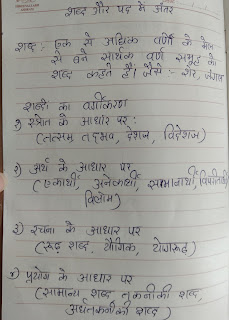IX A Science- Is Matter around us pure
Date- 12/8/21
Topic - Is Matter around us pure
Topic taught-
Separation of components of a mixture
Heterogeneous mixtures can be separated into their constituents by simple physical methods.
Methods include: handpicking, sieving, filtration.
Separation of Two Immiscible Liquids
Separation of a mixture of two immiscible liquids
- Separation of a mixture of two immiscible liquids is done by using a separating funnel.
- Applications: To separate a mixture of oil and water, in the extraction of iron from its ore.
Centrifugation
- Centrifugation uses centrifugal force for the separation of two liquids in a mixture.
- Here, a denser component of the mixture migrates away from the axis, and lighter component migrates towards the axis.
Sublimation
Sublimation is the transition of a substance from solid phase to gaseous phase without changing into liquid phase.
- Example: Naphthalene balls undergo sublimation.
- Chromatography
- Chromatography is used to separate the different components in a liquid mixture.
- It is based on the different properties of compounds in two phases: stationary and mobile phase.
- Distillation
- Distillation is a method for separating the component substances from a liquid mixture by selective evaporation and condensation.
Used in: Production of gasoline, distilled water, xylene, alcohol, paraffin, kerosene etc.
Fractional Distillation
Fractional Distillation is the separation of a mixture into its component parts or fractions by their melting points.
This is the process of separation of chemical compounds by their boiling point.
The mixture is heated to a temperature at which one or more fractions will vaporize.
Separation of Air into Its Components
Process of obtaining different gases from the air
Air is a homogeneous mixture and can be separated into its components by fractional distillation.
Fractional distillation
Crystallization
Crystallisation is a separation technique in which solids are separated from a solution.
In this technique, the solvent molecules start evaporating, leaving behind the solutes when the solution is heated in an open container.
Water Purification
Applications of crystallisation
Purification of seawater, separation of alum crystals from impure samples etc.
Elements
- Elements are species of atoms which have the same number of protons in their atomic nuclei.
- Elements are represented by symbols e.g.Hydrogen (H), Boron (B), Carbon (C), Silicon (Si) etc.
Metals
- Metal is a solid material which is typically hard, shiny, malleable, fusible, and ductile, with good electrical and thermal conductivity.
- Examples: Aluminium, Copper, Iron, Tin, Gold
Metalloids
- Metalloids exhibit some properties of metals as well as of non-metals.
- Examples: Boron, silicon, germanium, arsenic, antimony, and tellurium
Compounds
Nonmetals
- Non-metals are brittle and are not malleable or ductile.
- They are poor conductors of heat and electricity.
- Examples: Carbon, Boron etc.
Compounds
Compounds are the substances consisting of two or more different types of elements in a fixed ratio of its atoms.
Difference between mixtures and compounds
- Mixtures are constituted by more than one kind of pure form of matter, known as a substance.
- Types: Homogeneous Mixtures, Heterogeneous Mixtures
- When two or more elements chemically combine in a fixed ratio by mass, the obtained product is known as a compound.
Homework- Kindly submit Notebook work on Google classroom and Worksheets on Between us
Date- 13/8/21
CHAPTER- Is Matter around us pure
TOPIC TAUGHT- Revision of Chapter and Aceivement test
Homework- Submit Notebook work on Google classroom and Worksheets on Between us.
